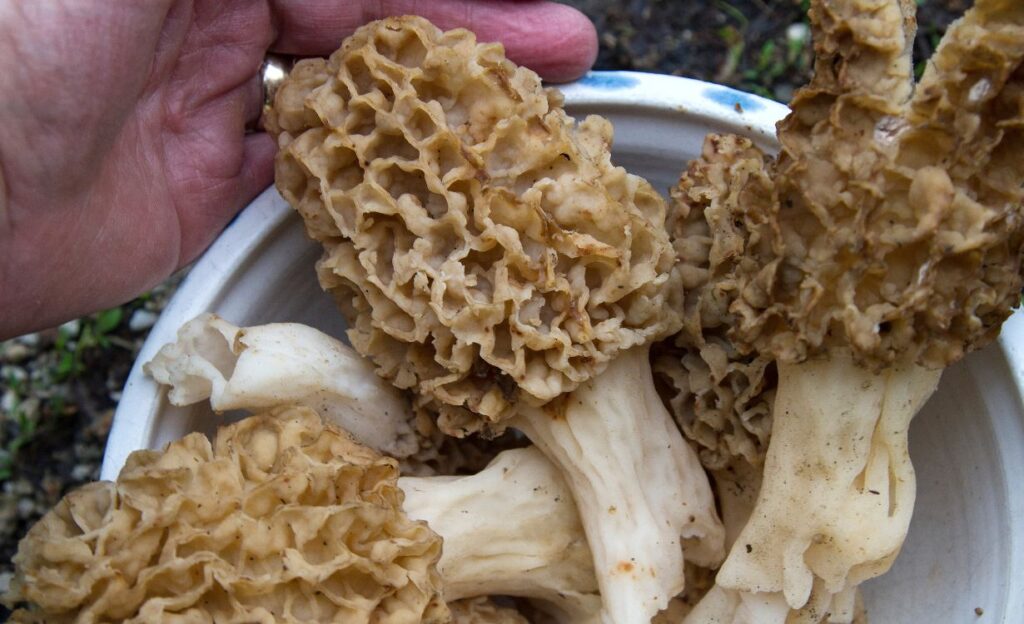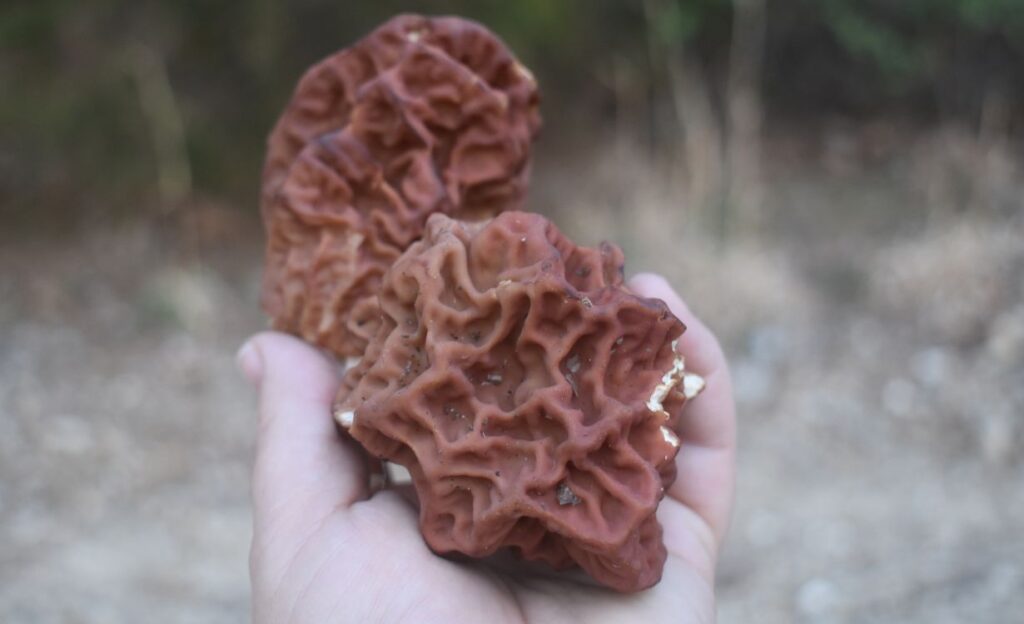
Morel Mushroom vs False Morel
Mushrooms are a delicious and nutritious addition to many dishes, but not all mushrooms are safe to eat. It is essential to correctly identify mushrooms before consuming them to avoid potential health risks. One common confusion among mushroom enthusiasts is distinguishing between morel vs false morel mushrooms.
Morel mushrooms are a popular edible mushroom with a unique flavor and texture, while false morels are toxic mushrooms that can cause serious health problems if consumed. In this blog post, we will discuss the differences between morel mushrooms and false morels and the importance of correctly identifying mushrooms before consumption.
What are Morel Mushrooms?

Morel mushrooms are a popular and sought-after edible mushroom known for their distinct cone-shaped caps and honeycomb-like texture. They are a member of the Morchellaceae family and are commonly found in North America, Europe, and Asia.
Physical characteristics of morel mushrooms:
Morel mushrooms typically have a tan to brownish cap that is deeply pitted with ridges and valleys that run vertically along the length of the cap. The caps are attached to a long, slender, and hollow stem that is also covered in pits and ridges. Morels can range in size from small to large and are generally about 2-4 inches in length.
Popular types of morel mushrooms:
There are several species of morel mushrooms that are commonly found in the wild. Some of the most popular species include the yellow morel (Morchella esculenta), the black morel (Morchella elata), and the half-free morel (Morchella semilibera). Each of these species has a slightly different appearance, but they are all considered to be edible and highly sought after by mushroom hunters.
Culinary uses of morel mushrooms:
Morel mushrooms have a unique earthy and nutty flavor that pairs well with a variety of dishes. They can be sautéed, roasted, grilled, or fried and are often used in soups, sauces, and pasta dishes. Morels are also commonly used as a topping for pizzas and in omelets and frittatas. Some people even use them as a meat substitute in vegetarian dishes.
In addition to their delicious flavor, morel mushrooms are also a good source of nutrients. They are low in calories and fat but high in protein, fiber, and various vitamins and minerals.
Overall, morel mushrooms are a delicious and nutritious addition to any meal. If you are interested in foraging for your own mushrooms, it is important to properly identify them and be aware of any potential risks.
What are False Morels?

False morels are mushrooms that are often mistaken for morel mushrooms, but they are a different species altogether. While they may look similar in appearance, false morels have some key physical differences that can help distinguish them from real morel mushrooms.
Physical characteristics of false morels:
One of the most noticeable physical differences between false morels and morel mushrooms is their cap shape. False morels have a brain-like, convoluted cap shape with folds and ridges, while morel mushrooms have a more distinct honeycomb-like cap with pits and ridges. False morels can also have a slimy or wrinkled appearance, with a reddish-brown color that can range from light to dark.
Popular types of false morels:
There are several types of false morels, but some of the most commonly found species include the Verpa bohemica, Gyromitra esculenta, and Gyromitra caroliniana. These false morels can be found in North America, Europe, and Asia, and they are often mistaken for true morel mushrooms due to their similar appearance.
Toxicity of false morels:
One of the most significant differences between false morels and true morels is their toxicity. False morels are considered to be highly toxic and can cause serious health problems if consumed. The toxins in false morels are called gyromitrin, which can cause liver damage, gastrointestinal distress, and even death. Symptoms of gyromitrin poisoning can include headaches, nausea, vomiting, dizziness, and seizures.
However, it is essential to be able to distinguish between true morel mushrooms and false morels. While they may look similar, false morels can be highly toxic and should not be consumed. It is always best to err on the side of caution and seek the advice of an experienced mushroom hunter or mycologist before consuming any wild mushrooms.
Morel vs False Morel Mushrooms | How to Tell the Difference
Identifying the differences between morel mushrooms and false morels can be a bit tricky, but there are several key characteristics to look out for. Here are some ways to tell the difference between these two types of mushrooms:
Key differences in appearance between morel mushrooms and false morels:
- Morel mushrooms have a distinctive, honeycomb-shaped cap with deep ridges and pits.
- False morels, on the other hand, have a brain-like cap with folds and wrinkles that are irregularly shaped and not as pronounced as the ridges on morel mushrooms.
Smell, texture, and taste differences:
- Morel mushrooms have a strong, earthy aroma and a meaty, nutty flavor.
- False morels, on the other hand, have a slightly sweet or fruity aroma and a slightly bitter taste.
- Morel mushrooms have a hollow stem, while false morels have a solid stem that is often filled with cotton-like fibers.
It’s important to note that while morel mushrooms have a distinct appearance and aroma, false morels can be more difficult to identify. Some species of false morels can look very similar to morel mushrooms, so it’s crucial to be certain of the identification before consuming them.
In addition to these characteristics, it’s important to research the geographic location where you’re foraging for mushrooms. False morels tend to grow in areas with decaying wood, while morel mushrooms prefer areas with rich, organic soil.
It’s always a good idea to consult with an experienced forager or mushroom identification expert to help you identify the differences between morel mushrooms and false morels. Remember, the consequences of misidentifying these mushrooms can be severe, so it’s better to err on the side of caution.
Importance of Accurate Identification
One of the most critical reasons why you need to learn how to distinguish between morel mushrooms and false morels is for your safety. False morels can be toxic, causing various symptoms that can range from mild to severe. The danger of consuming these toxic mushrooms can lead to severe health complications, which may require medical attention.
Dangers of Consuming False Morels
False morels contain a toxin called gyromitrin, which can cause symptoms such as nausea, vomiting, abdominal pain, dizziness, and headache. In some cases, people may experience more severe symptoms, including seizures, coma, and even death.
Risks of Misidentifying Mushrooms
Misidentifying mushrooms can result in consuming poisonous mushrooms, which can be fatal. Some wild mushrooms that look similar to morel mushrooms are poisonous, and ingesting them can lead to severe symptoms or even death. Therefore, it is crucial to be familiar with the physical characteristics of morel mushrooms and false morels to avoid misidentification and accidental consumption.
Moreover, consuming toxic mushrooms is not the only risk of misidentifying mushrooms. Mushroom hunters may face legal repercussions for accidentally picking a protected or endangered mushroom species, which may result in fines or other legal consequences.
Overall, accurate identification of mushrooms, particularly morel mushrooms and false morels, is crucial for safety and legal reasons. Mushroom hunters and enthusiasts should be familiar with the physical characteristics of different types of mushrooms and understand the risks of misidentification. Remember, if you are not sure about the identification of a mushroom, it is better to err on the side of caution and avoid consuming it.
FAQs on Morel Mushrooms vs False
As a mushroom enthusiast or someone who enjoys foraging for food, it’s important to learn how to differentiate between false morels and morel mushrooms. To help you understand more about these mushrooms, we’ve compiled some frequently asked questions.
What happens if you eat false morels?
If you consume false morels, you may experience symptoms such as nausea, vomiting, abdominal pain, diarrhea, dizziness, headache, muscle cramps, bloating, and fatigue. In severe cases, it can lead to confusion, delirium, seizures, and even coma. False morels contain a toxin called gyromitrin, which can be fatal if not treated.
Are false morels near real morels?
False morels grow in the same habitat as true morels, which can make it easier to mistake the two when hunting for mushrooms. False morels can grow in a specific area in small numbers or an entire bunch of morels.
Do false morels come up before morels?
False morels usually appear a few weeks earlier than true morels, depending on where you live. In Alberta, Verpa bohemica shows up in early May.
Can you get sick from touching false morels?
Touching a false morel won’t harm you. However, the problem arises when you eat it or inhale steam while cooking it. Gyromitrin is the active toxin in false morels, and it is metabolized by your body into monomethylhydrazine, which is a chemical found in rocket fuel.
Do morels only grow around dead trees?
Morel mushrooms usually grow on the edges of wooded areas, especially around oak, elm, ash, and aspen trees. Look for dead or dying trees while hunting, as morels tend to grow right around the base. Additionally, recently disturbed areas are also great places to find mushrooms.
Final Thoughts on False vs Real Morel Mushrooms
In conclusion, it’s essential to be able to differentiate between morel mushrooms and false morels for safe consumption. Morel mushrooms have distinctive characteristics, including a cone-shaped cap with pits and ridges, while false morels have a wrinkled, brain-like cap. Additionally, the stems of morels are hollow, while false morels have a cottony or solid stem.
Misidentifying mushrooms can lead to accidental consumption of toxic mushrooms, which can cause severe symptoms and even death. Therefore, it’s crucial to take the time to learn the physical characteristics of different mushrooms, particularly morel mushrooms and false morels.
By emphasizing the importance of accurate identification, mushroom hunters and enthusiasts can enjoy their hobby safely and responsibly. Always exercise caution and consult an expert if you are unsure about the identification of a mushroom. With the proper knowledge and precautions, you can safely enjoy the unique flavors and nutritional benefits of these fascinating fungi.

Hi, I’m Miles, the lead team member behind Gardeem.com. Besides being a passionate grower and writer, I’m a husband, father and grandfather to three! I started Gardeem in 2017 to provide simple and reliable gardening advice to everyone, regardless of their ability levels.






